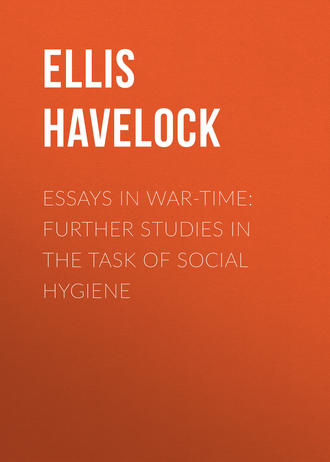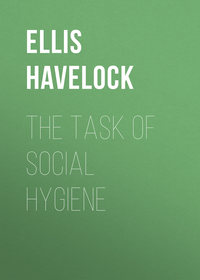 полная версия
полная версияEssays in War-Time: Further Studies in the Task of Social Hygiene
47
This is especially true of many regions in America, both North and South, where a hideous mixture of disparate nationalities furnishes conditions peculiarly favourable to the "White Slave Traffic," when prosperity increases. See, for instance, the well-informed and temperately written book by Miss Jane Addams, A New Conscience and an Ancient Evil, 1912.
48
See Havelock Ellis: Sex in Relation to Society (Studies in the Psychology of Sex), Vol. VI., Ch. VII.
49
"The White Slave Traffic," English Review, June, 1913. It is just just the same in America. Mr. Brand-Whitlock, when Mayor of Toledo, thoroughly investigated a sensational story of this kind brought to him in great detail by a social worker and found that it possessed not the slightest basis of truth. "It was," he remarks in an able paper on "The White Slave" (Forum, Feb., 1914), "simply another variant of the story that had gone the rounds of the continents, a story which had been somehow psychologically timed to meet the hysteria which the pulpit, the Press, and the legislature had displayed."
50
G.F. Collas, Geschichte des Flagellantismus, 1913, Vol. I., p. 16.
51
I have brought together some of the evidence on this point in the chapter on "Immorality and the Law" in my book, The Task of Social Hygiene.
52
The idea is cherished by many, especially among socialists, that prostitution is mainly an economic question, and that to raise wages is to dry up the stream of prostitution. That is certainly a fallacy, unsupported by careful investigators, though all are agreed that the economic condition of the wage-earner is one factor in the problem. Thus Commissioner Adelaide Cox, at the head of the Women's Social Wing of the Salvation Army, speaking from a very long and extensive acquaintance with prostitutes, while not denying that women are often "wickedly underpaid," finds that the cause of prostitution is "essentially a moral one, and cannot be successfully fought by other than moral weapons."—(Westminster Gazette, Dec. 2nd, 1912). In a yet wider sense, it may be said that the question of the causes of prostitution is essentially social.
53
This is a very important clue indeed in dealing with the problem of prostitution. "It is the weak-minded, unintelligent girl," Goddard states in his valuable work on Feeblemindedness, "who makes the White Slave Traffic possible." Dr. Hickson found that over 85 per cent. of the women brought before the Morals Court in Chicago were distinctly feeble-minded, and Dr. Olga Bridgeman states that among the girls committed for sexual delinquency to the Training School of Geneva, Illinois, 97 per cent. were feeble-minded by the Binet tests, and to be regarded as "helpless victims." (Walter Clarke, Social Hygiene, June, 1915, and Journal of Mental Science, Jan., 1916, p. 222.) There are fallacies in these figures, but it would appear that about half of the prostitutes in institutions are to be regarded as mentally defective.
54
The increase of venereal disease during the Great War has been noted alike in Germany, France, and England. Thus, as regards France, Gaucher has stated at the Paris Academy of Medicine (Journal de Medicine, May 10th, 1916) that since mobilisation syphilis had increased by nearly one half, alike among soldiers and civilians; it had much increased in quite young people and in elderly men. In Germany, Neisser, a leading authority, states (Deutsche Medizinische Wochenschrift, 14th Jan., 1915) that the prevalence of venereal disease is much greater than in the war of 1870, and that "every day many thousands, not to say tens of thousands, of otherwise able-bodied men are withdrawn from the service on this account."
55
The chief is Iwan Bloch who, in his elaborate work, Der Ursprung der Syphilis (2 vols., 1901, 1911), has fully investigated the evidence.
56
N. Bishop Harman, "The Influence of Syphilis on the Chances of Progeny," British Medical Journal, Feb. 5th, 1916.
57
It is true that in my book, Sex in Relation to Society (Ch. VIII.) I have stated my belief that notification, as in the case of other serious infectious diseases, is the first step in the conquest of venereal disease. I still think it ought to be so. But a yet more preliminary step is popular enlightenment as to the need for such notification. The recommendations seem to me to go as far as it is possible to go at the moment in English-speaking countries without producing friction and opposition. In so far as they are carried out the recommendations will ensure the necessary popular enlightenment.
58
The result sometimes is that the ambitious doctor seeks to become a specialist in at least one subject, and instals a single expensive method of treatment to which he enthusiastically subjects all his patients. This would be comic if it were not sometimes rather tragic.
59
A Danish alienist, Lange, has, however, made an attempt on a statistical basis to show a connection between mental ability and mental degeneracy. (F. Lange, Degeneration in Families, translated from the Danish, 1907). He deals with 44 families which have provided 428 insane or neuropathic persons within a few generations, and during the same period a large number also of highly distinguished members, Cabinet ministers, bishops, artists, poets, etc. But Lange admits that the forms of insanity found in these families are of a slight and not severe character, while it is clear that the forms of ability are also in most cases equally slight; they are mostly "old" families, such as naturally produce highly-trained and highly placed individuals. Moreover, Lange's methods and style of writing are not scientifically exact, and he fails to define precisely what he means by a "family." His investigation indicates that there is a frequent tendency for men of ability to belong to families which are not entirely sound, and that is a conclusion which is not seriously disputed.
60
Havelock Ellis, A Study of British Genius, 1904.
61
Dr. Cabanès (Indiscrétions de l'Histoire, 3rd series) similarly concludes that, while in temperament Napoleon may be said to belong to the epileptic class, he was by no means an epileptic in the ordinary sense. Kanngiesser (Prager Medizinische Wochenschrift, 1912, No. 27) suggests that from his slow pulse (40 to 60) Napoleon's attacks may have originated in the heart and vessels.
62
Genuine epilepsy usually comes on before the age of twenty-five; it very rarely begins after twenty-five, and never after thirty. (L.W. Weber, Münchener Medizinische Wochenschrift, July 30th and Aug. 6th, 1912.) In genuine epilepsy, also, loss of consciousness accompanies the fits; the exceptions to this rule are rare, though Audenino, a pupil of Lombroso, who sought to extend the sphere of epilepsy, believes that the exceptions are not so rare as is commonly supposed (Archivio di Psichiatria, fasc. VI., 1906). Moreover, true epilepsy is accompanied by a progressive mental deterioration which terminates in dementia; in the Craig Colony for Epileptics of New York, among 3,000 epileptics this progressive deterioration is very rarely absent (Lancet, March 1st, 1913); but it is not found in the distinguished men of genius who are alleged to be epileptic. Epileptic deterioration has been elaborately studied by MacCurdy, Psychiatric Bulletin, New York, April, 1916.
63
See, e.g., Elizabeth du Quesne van Gogh, Personal Recollections of Vincent van Gogh, p. 46. These epileptic attacks are, however, but vaguely mentioned, and it would seem that they only appeared during the last years of the artist's life.
64
He has further discussed the subject in Die Neue Generation, Aug.-Nov., 1914, and in a more recent (1916) pamphlet which I have not seen.
65
The reference is to The Century of the Child, by Ellen Key, who writes (English translation, p. 2): "My conviction is that the transformation of human nature will take place, not when the whole of humanity becomes Christian, but when the whole of humanity awakens to the consciousness of the 'holiness of generation.' This consciousness will make the central work of Society the new race, its origin, its management, and its education; about these all morals, all laws, all social arrangements will be grouped."
66
It is not only ability, but idiocy, criminality and many other abnormalities which specially tend to appear in the first-born. The eldest-born represents the point of greatest variation in the family, and the variation thus yielded may be in either direction, useful or useless, good or bad. See, e.g., Havelock Ellis, A Study of British Genius, pp. 117-120. Sören Hansen, "The Inferior Quality of the First-born Children," Eugenics Review, Oct., 1913.
67
Marro, La Pubertà (French translation La Puberté), Ch. XI.
68
It is this artificial and external pressure which often produces a revolt against marriage. The author of a remarkable paper entitled, "Our Incestuous Marriage," in the Forum (Dec., 1915), advocates a reform of social marriage customs "in conformance with the freedom-loving modern nature," and the introduction of "a fresh atmosphere for married life in which personality can be made to appear so sacred and free that marriage will be undertaken and borne as lightly and gracefully as a secret sin."
69
See Sir James Donaldson, Woman: Her Position and Influence in Ancient Greece and Rome, 1907; also S.B. Kitchin's excellent History of Divorce, 1912; this author believes that the tendency in modern civilisation is to return to the simple principles of Roman law involving divorce by consent. See also Havelock Ellis, Sex in Relation to Society, Ch. X.
70
For a more detailed discussion of these points see the author's Task of Social Hygiene.
71
Those who wish to study the latest restatements of opinions in England may be recommended to read the Report of the Commission of Inquiry into Great Britain's falling birth-rate, appointed in 1913 by the National Council of Public Morals, under the title of The Declining Birth-rate: Its Causes and Effects, 1916.
72
J.M. Coulter, The Evolution of Sex in Plants, 1915; Geoffrey Smith, "The Biology of Sex," Eugenics Review, April, 1914.
73
See, e.g., Geddes and Thomson, The Evolution of Sex, Ch. XX.; and T.H. Morgan, Heredity and Sex, Ch. I.
74
To quote one of the most careful investigators of this point, Northcote Thomas, among the Edo-speaking people of Nigeria, found that the average number of living children per husband was 2.7; including all children, alive and dead, the average number was per husband 4.5, and per wife 2.7. "Infant mortality is heavy" (Northcote Thomas, Anthropological Report of Edo-speaking People of Nigeria, 1910, Part I., pp. 15, 63).
75
The same end has been rather more mercifully achieved in earlier periods by infanticide (see Westermarck, Origin and Development of the Moral Ideas, Vol. I., Ch. 17). It must not be supposed that infanticide was opposed to tenderness to children. Thus the Australian Dieyerie, who practised infanticide, were kind to children, and a mother found beating her child was herself beaten by her husband.
76
See Havelock Ellis, The Nationalisation of Health.
77
Similar results appear to follow in China where also the birth-rate is very high and the mortality very great. It is stated that physical development is much inferior and pathological defects more numerous among Chinese as compared with American students. (New York Medical Journal, Nov. 14th, 1914, p. 978.) The bad conditions which produce death in the weakest produce deterioration in the survivors.
78
The law is thus laid down by P. Leroy-Beaulieu (La Question de la Population, 1913, p. 233): "The first degree of prosperity in a rude population with few needs develops prolificness; a later degree of prosperity, accompanied by all the feelings and ideas stimulated by the development of education and a democratic environment, leads to a gradual reduction of prolificness."
79
This is too often forgotten. Birth control is a natural process, and though in civilised men, endowed with high intelligence, it necessarily works in some measure voluntarily and deliberately, it is probable that it still also works, as in the evolution of the lower animals, to some extent automatically. Sir Shirley Murphy (Lancet, Aug. 10th, 1912), while admitting that intentional restriction has been operative, remarks: "It does not appear to me that there is any more reason for ignoring the likelihood that Nature has been largely concerned in the reduction of births than for ignoring the effects of Nature in reducing the death-rate. The decline in both has points of resemblance. Both have been widely manifest over Europe, both have in the main declined in the period of 1871-1880, and indeed both appear to be behaving in like manner."
80
I do not overlook the fact that the artificial clothing of primitive man is in its origin mainly ornament, having myself insisted on that fact in discussing this point in "The Evolution of Modesty" (Studies in the Psychology of Sex, Vol. I.). It is to be remembered that, in animals—and very conspicuously, for instance, in birds—natural clothing is also largely ornament of secondary sexual significance.
81
At the end of the eighteenth century there were in France four children on the average to a family; a movement of rapid increase in the population reached its climax in 1846; by 1860 the average number of children to a family had slowly fallen to but little over three. Broca, writing in 1867 ("Sur la Prétendue Dégénérescence de la Population Francaise"), mentioned that the slow fall in the birth-rate was only slightly due to prudent calculation and mainly to more general causes such as delay in marriage.
82
Havelock Ellis, Studies in the Psychology of Sex, Vol. VI., "Sex in Relation to Society," Ch. XI., The Art of Love.
83
The exact results are presented by F. Boas (abstract of Report on Changes in Bodily Form of Descendants of Immigrants, Washington, 1911, p. 57), who concludes that "the physical development of children, as measured by stature, is the better the smaller the family."
84
R.J. Ewart, "The Influence of Parental Age on Offspring," Eugenics Review, Oct., 1911.
85
In New Zealand the birth-rate is very low; but the death-rate of children in the first year is only 58 per thousand as against 130 in England.
86
E.M. Elderton, Report on the English Birth-rate, Part I., 1914. See also the collection of narratives of their experiences by working-class mothers, published under the title of Maternity (Women's Co-operative Guild, 1915).
87
Flinders Petrie, Journal of the Anthropological Institute, 1906, p. 220.





